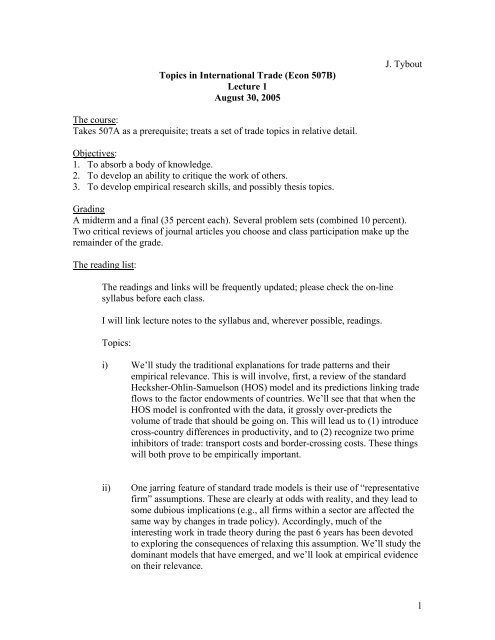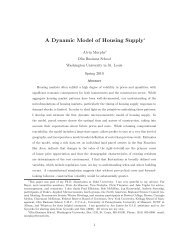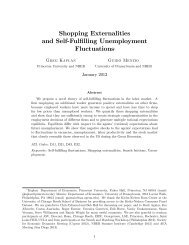1 J. Tybout Topics in International Trade (Econ 507B) Lecture 1 ...
1 J. Tybout Topics in International Trade (Econ 507B) Lecture 1 ...
1 J. Tybout Topics in International Trade (Econ 507B) Lecture 1 ...
Create successful ePaper yourself
Turn your PDF publications into a flip-book with our unique Google optimized e-Paper software.
K1/r Good AGood BGood C1/wLThis diagram also shows the equilibrium factor <strong>in</strong>tensities for production of each good asrays through the orig<strong>in</strong>. Because we are assum<strong>in</strong>g constant returns to scale, volumes ofproduction are proportional to factor usage, i.e., distance along the rays to the productionpo<strong>in</strong>t.Perfect competition also implies full employment of resources. More precisely, by theenvelope theorem, the cost-m<strong>in</strong>imiz<strong>in</strong>g vector of <strong>in</strong>put requirements for a unit of output is∂gi= ai(w) , where ai( w)= ( ai1(w),ai2( w),K,aiM( w))' . Thus the full employment∂wcondition is:∑ aij ( w)Y i=V j j = 1, K,M , (2)iwhere V j is the economy-wide stock of factor j and y j is the amount of good j produced.Us<strong>in</strong>g matrix notation these M equations can be written compactly as:AY = V (2’)In the case of two factors the full employment condition can depicted graphically as therequirement that the sum of the factor employment rays yields the endowment po<strong>in</strong>t.Note that with more goods than factors, there is an <strong>in</strong>f<strong>in</strong>ite number of possible ways thefull employment condition might be satisfied at a given set of factor prices:3
KC ECBALF<strong>in</strong>ally, assume that consumers everywhere have identical homothetic tastes, so that theshare of their <strong>in</strong>come they spend on good i depends only on the price vector, α i ( p), i = 1,… n.We are now prepared to say someth<strong>in</strong>g about the way that production vectors, Y i , varyacross countries with factor endowments, V i . This will set the stage for a statement aboutthe relationship between trade flows and factor endowments.The key observation is that equation 2’ describes the l<strong>in</strong>k between output vectors andendowment vectors for all countries, so long as all countries share the same factor prices.We thus want to know when this will occur.Suppose the world is comprised of countries <strong>in</strong>dexed by c = 1, …,C. Also, assume thatfree world trade ensures that the same product prices prevail everywhere. Then if the setof n equations (1) holds with equality for every country, and if these equations imply aone-to-one mapp<strong>in</strong>g from factor price vectors to output price vectors, the same set offactor prices will prevail everywhere (factor price equalization). Further, these factorprices will <strong>in</strong>duce the same factor <strong>in</strong>tensities everywhere. That is, all countries will sharethe same technology matrix, A.When does this occur? Th<strong>in</strong>k of an <strong>in</strong>tegrated equilibrium (IE) <strong>in</strong> which we pool globalresources <strong>in</strong>to one giant economy. (Equivalently, th<strong>in</strong>k of all factors as perfectly mobileacross borders.) There is some vector of market clear<strong>in</strong>g product prices <strong>in</strong> thisequilibrium, an associated vector of factor prices, and a matrix of factor <strong>in</strong>tensities, A.Now, start<strong>in</strong>g from this IE, imag<strong>in</strong>e that we divide up the world’s factor endowmentamong countries and we prohibit <strong>in</strong>ternational factor movements. If the division is done4
<strong>in</strong> such a way that all countries’ factor endowment vectors are identical up to a scalarmultiple, then the IE need not be disturbed. Because production technologies arehomogeneous of degree 1, a country gett<strong>in</strong>g some fraction 8 c of the global endowment,V c= λ , could simply produce the same fraction of the global output vector. TherecVWwould be no effect on global supplies of goods, so no adjustment <strong>in</strong> prices would benecessary. Thus, so long as the equilibrium vector of output prices implied a uniquevector of factor prices, the <strong>in</strong>tegrated equilibrium (IE) would be replicated. (Would therebe any need for trade?)More <strong>in</strong>terest<strong>in</strong>gly, when divid<strong>in</strong>g up the world’s endowment, it is possible to preservethe IE even if we deviate from proportionate endowments. But if endowments get too farfrom proportionality, it will be necessary for countries to deviate from the IE factor<strong>in</strong>tensities <strong>in</strong> order to use all of their factor stocks, caus<strong>in</strong>g factor prices to deviate too.Consider the example depicted below with 3 goods (A,B,C), 2 countries (1,2), and 2factors (K,L). Here the l<strong>in</strong>e segments A, B and C represent factor usage <strong>in</strong> each goodwhen the IE obta<strong>in</strong>s. Any po<strong>in</strong>t enclosed by the convex hull represents an endowmentdivision that preserves the IE, because this set of po<strong>in</strong>ts allows the two countries toreplicate the production vectors A,B and C between them.L 2K 1 Country 2orig<strong>in</strong>CBs 2AFactor price equalization set•s 1 i • ii •Country 1 L 1Orig<strong>in</strong> K 2At endowment po<strong>in</strong>t (i), is the production mix determ<strong>in</strong>ant?Mov<strong>in</strong>g toward (ii), what happens to A’s production mix?Answer: even if 1 supplies all of the most labor-<strong>in</strong>tensive goods demanded, it can’tabsorb its factor stocks at (ii) us<strong>in</strong>g the factor <strong>in</strong>tensities of the <strong>in</strong>tegrated equilibrium.Factor prices and output prices will have to adjust, so the <strong>in</strong>tegrated equilibrium won’t bereplicated. Some countries won’t be produc<strong>in</strong>g the entire set of goods, and the same goodwill be produced us<strong>in</strong>g different factor <strong>in</strong>tensities <strong>in</strong> different countries.In short, some major simplifications emerge so long as if countries don’t differ too much<strong>in</strong> their relative factor abundance.5
A producers’ eye view: In the <strong>in</strong>tegrated equilibrium (IE), the same factor prices prevaileverywhere, all goods are producible at zero profit <strong>in</strong> each country, and each uses thesame factor <strong>in</strong>tensities:K1/r Good AGood BGood CL1/wBut suppose that at IE prices, country 1 wants to supply too much of good C to clear themarket. Then the relative price of C will adjust until a new equilibrium obta<strong>in</strong>s, and theunit value isoquant will shift, perhaps as below. Now country 1 produces only B and Cwhile 2 produces only A and B, and FPE fails. Note that different countries use differentfactor <strong>in</strong>tensities to produce the same good (B).KGood AGood B1 Good C2 L6
Formally, Helpman and Krugman (1985, chapter 1) describe the set of factorendowments that lead to FPE (with no non-traded goods) as:⎪⎧FPE = ⎨( V 1,V 2,K , V C ) | ∃λic≥ 0, ∑λic= 1 ∀i∈ I ∋ V c = ∑λicV⎪⎩c∈Ci∈IiW⎪⎫∀c∈ C⎬⎪⎭Any factor allocation across C countries that leads to FPE must be consistent with nonnegativeoutputs of each good <strong>in</strong> each country, when (1) global output levels of eachgood match those of the <strong>in</strong>tegrated equilibrium, and (2) each country exhausts itsendowments when us<strong>in</strong>g production techniques that reflect the <strong>in</strong>tegrated equilibriumfactor <strong>in</strong>tensities. (V iW is the vector of global factor usage for production of good i <strong>in</strong> theIE, and 8 ic is the share of global i production done <strong>in</strong> country c.)Sufficient conditions for FPE are:i) all C countries share the same technology (production functions);ii) there are at least as many goods as factors (why?);iii) there are no factor <strong>in</strong>tensity reversals;iv) at equilibrium prices, all goods can be produced <strong>in</strong> each country at zero profit.Note: with factor <strong>in</strong>tensity reversals, the same set of goods may be produced differently<strong>in</strong> two countries, given the same set of output prices. Thus the mapp<strong>in</strong>g from prices tofactor prices cannot be one to one.KAB21L7
















